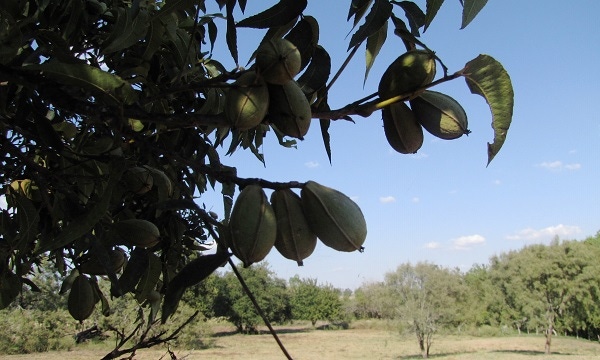
Multiple years of serious drought has taken a toll on pecan trees across the Southwest, but in spite of dry conditions, most growers in Texas, Oklahoma and New Mexico are reporting fair to good nut conditions as early harvest gets underway.
Nationwide, pecan production is expected to be down this year with the exception of the Georgia crop, but thanks to heavy late summer/early fall rains across the Southwest, crop conditions and outlook have improved slightly, especially in New Mexico where it appears to be an on-year in pecan’s alternate bearing cycle for most growers.
Irrigation allotments from both the Rio Grande and Pecos Rivers have been extremely limited or non-existent, but application of ground water irrigation appears to have been sufficient to sustain trees until an active monsoon season hit in mid July. Pest pressure from aphids and pecan nut casebearers has been light to moderate most of the year in high-production areas.
If you are enjoying reading this article, please check out Southwest Farm Press Daily and receive the latest news right to your inbox.
In Eddy County, Carlsbad Irrigation District (CID) officials say the rains came at the right time for pecan and cotton growers. In fact, rains were so productive that CID officials authorized limited irrigation releases late in the growing season, which further helped pecan growers and improved nut conditions.
In Texas, Extension specialists are predicting higher consumer prices for the smaller crop, an off-year in the production cycle. Extreme drought conditions stressed trees until the rains came in late summer. Those rains, many of them heavy, saturating events, helped to improve nut conditions, though many trees had already been lost.
In spite of a light nut load reported by most commercial growers across the state, the quality of Texas pecans will be high, according to a Texas A&M AgriLife Extension Service specialist.
“They (consumers) should expect to pay a little more, though, as yields are light,” said Dr. Larry Stein, AgriLife Extension horticulturist in Uvalde. “There are pecans – it’s not like it’s a total washout, and in certain places there are more pecans than we expected.”
Stein said Dry weather cut back yields this year, but not to the degree it did in 2011, and irrigated pecan growers are expecting adequate, though not high, yields. Drier weather means lower disease problems, so the quality should be very good, particularly on irrigated orchards.
“Where the crop is really short, you’ve got to realize the varmints are working them hard,” Stein added. “The crows, squirrels, raccoons, turkey and deer – you name it – are all getting their share right now. And as they say, ‘a short crop always gets shorter and big crop will always get bigger.’”
Prices expected to rise
Stein and other pecan specialists agree that pecan prices are going up, pushed higher by greater demand created by the holidays. November grocery store prices potentially could reach as high as $11 a pound or more.
In Oklahoma, production will again be down this year, partially because of prevailing drought conditions but also as a result of three late freezes earlier this year.
"Our last and most destructive freeze came in May and that alone will cut deeply into our production numbers. But another factor will be pecan prices. Last year many producers left nuts on the tree because there was no money in harvesting them," said Dr. Charles Rohla, Noble Foundation researcher and assistant professor. "About 70 cents a pound is break even and I have heard that was the going price in Louisiana a couple of weeks ago, so we are hoping prices will go up for the holidays in order to make it a profitable crop this year."
Rohla says 85 percent of Oklahoma's pecans are native varieties, which are normally smaller nuts.
"Right now we are looking at commercial production numbers to range between 8 to 10 million pounds of pecans this year, and this is down considerably from last year's 28 million pounds," he said.
Dohla says Oklahoma has lost as much as 20 percent of its pecan trees to drought and freeze conditions over the last two years.
The 2012 U.S. pecan crop totaled 302.8 million pounds or 151,400 tons, a 12 percent increase from 2011. The value of the 2012 pecan crop decreased 27 percent to $476.8 million. Production was so good that as the year ended, much of the crop was stored and is still being sold, a development that has helped to keep prices down.
But experts say as the last of the 2012 crop is exhausted, prices will rise as the new crop hits the market. Commercial pecan production was reported in 14 states, and overall the United States produced more than 80 percent of the world’s pecans. Nearly three-fourths of U.S. pecans were produced in the states of Georgia, New Mexico and Texas.
Georgia led the nation in pecan production, with production for all pecans (improved varieties and native and seedling) reaching 100 million pounds, followed by New Mexico at 65 million pounds, Texas at 55 million pounds, Oklahoma at 28 million pounds and Arizona at 20 million pounds.
The value of pecan production in four of the top five states declined in 2012. Only Oklahoma experienced an increase in the value of pecan production from $11.4 million in 2011 to $24.7 million in 2012.
Also of interest on Southwest Farm Press:
Fruit, nut producers to benefit from TDA grant
About the Author(s)
You May Also Like




